Sanchi Monument: A Rediscovery
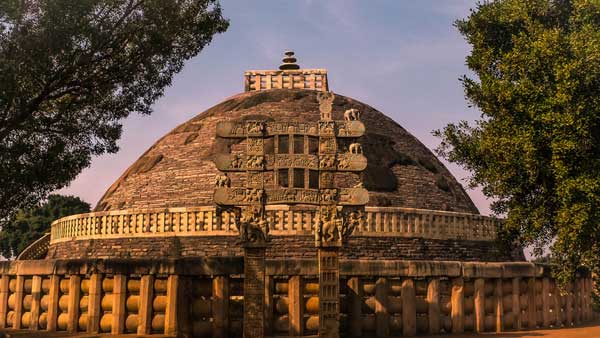
The Great Stupa of Sanchi. Source: Wikipedia.
Sanchi is one of India’s most well-preserved and studied Buddhist sites. It is located at a hilltop in the town of Sanchi in Madhya Pradesh. It covers an area of seventeen miles, east and west and about ten miles, north and south. There are many stupas at the site, amongst which the Sanchi Stupa also known as the Great Stupa is considered the most prominent. The Great Stupa was built by Ashoka in the third century BC. It enshrines religious relics or remains of the Buddha and his most revered disciples.
The mound of the stupa was built during the time of Ashoka. Over the course of the next thirteen centuries, expansion to the stupa kept taking place. In the middle of the second century BC, during the Shunga period, the original brick structure was enlarged to twice its size and the mound was covered in sandstone slabs.
A circumambulatory walkway was constructed around the stupa which was bounded by a stone railing also known as a vedika. Circumambulation or pradakhshina is an important part of ritual and devotional practices in Buddhism. Moreover, a harmika or a square structure was also added to the stupa. The harmika is placed on the top of the stupa and contains a three-tiered umbrella or chattravali which represents the three Jewels of Buddhism- the Buddha, the dharma (the teachings of Buddha) and the sangha (Buddhist order).
The most elaborate additions to the stupa were made during the Satavahana period from the first century BC to the second century AD. Four stone gateways or toranas were added to the stupa in the four cardinal directions. These toranas comprise of two stone pillars which are surmounted by capitals (the topmost member of a column). The capitals in turn support three architraves (lintel or beam which extends from column to column and rests on their capitals) with volute (scroll-like ornamentation found in the capital of an Ionic column) ends. These architraves are richly carved with episodes from the life of Buddha and the Jatakas (stories from the life of Buddha).
The chronological sequence of the four gateways are as follows: Southern, Northern, Eastern and Western. All these gateways were donated by devout people and their names were inscribed on its pillars. The richly carved pillars are considered to be historically important because of the relief figures on them. These figures offer a glimpse into the life of the people in the third quarter of the first century B.C.

Temptation of the Buddha on the north gateway architrave, Great Stupa. Source: Wikipedia Commons
Further additions to Sanchi were made during the Gupta period. These include a Buddhist temple and a lion pillar. The victory inscription of Chandragupta II is carved on the railing of the Great Stupa, dating to the fourth century A.D. The site is said to have been a thriving religious centre from the third century BC to the thirteenth century AD. Its decline as a prominent religious site coincided with the decline of Buddhism in the Indian subcontinent.
In 1818, the British rediscovered the Sanchi site. The rediscovery is attributed to General Henry Taylor of the Bengal Cavalry. The almost intact condition of the Great Stupa at Sanchi generated interest among a growing breed of explorers and amateur archaeologists who were mostly army officials and travelling antiquarians.
The first scientific excavation of the stupa took place in 1851 under the supervision of Major Alexander Cunningham. He along with his colleague, Lieutenant-Colonel F.C. Maisey made drawings of the site. The relics of the Buddha’s two chief disciples were found in the ruins of Stupa No.3 at Satdhara (six and a half miles west of Sanchi) which measured about forty feet in diameter and was smaller than the Great Stupa.
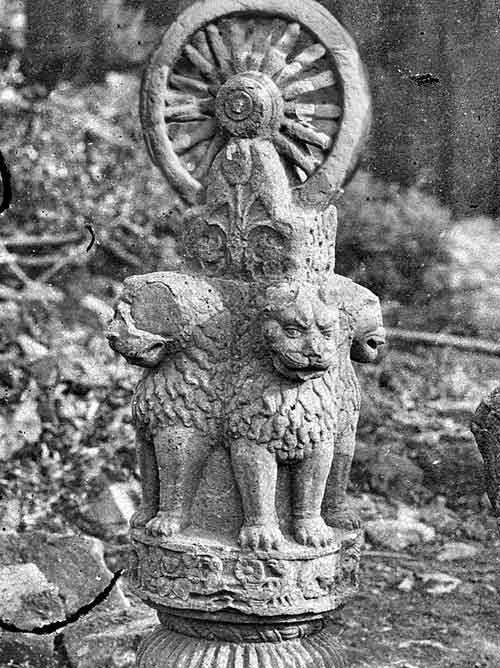
Lion captial near northern gateway at Sanchi. Source: Wikipedia.

Sketch map showing positions of group of topes around Bhilsa. Source: "The Bhilsa Topes", Alexander Cunningham, 1854.
Besides the Sanchi site, they also conducted excavations in the surrounding stupas of Sonari, Satdhara, Bhojpur and Andher situated at six and twelve miles from Sanchi. Here too many precious discoveries were made.These relic finds were then distributed between Cunningham and Maisey and almost all the reliquaries were sent to England.
On 23rd November 1853 , the British Resident at Indore, Sir Robert North Collie Hamilton sent a communication to the Governor General of India in Council regarding an offer made by Sikander Begum, the Begum of Bhopal to present the carved stones of two of the Gateways of the Tope (northern and eastern) at Sanchi Kana Kheree to Queen Victoria.
Preparations were made for the removal of the richly carved stones of the two gateways to be sent to London. However, the expense and care required to dismantle the structure without destroying the intricate carvings delayed the plans for their removal. The lack of proper means of transport to Bombay led to the suspension of the removal. The grand arrangements for the removal and transportation of these gateways also suffered a setback as the Rebellion of 1857 led the British government and the Bhopal Durbar into a highly-charged political situation.
In 1868, the Begum of Bhopal renewed her offer to send the gateways to the British Museum. However, this time the begum’s offer was declined by the colonial authority as they were invested in following a strategy of in-situ preservation and conservation of monuments. Instead, the plaster cast of the eastern gateway was prepared under the supervision of Lieutenant Henry H. Cole of the Royal Engineers in 1869 to be sent to the South Kensington Museum in London. It was an extensive exercise which involved the recruitment of personnel from the Royal Engineers and training in the making of casts from gelatine, piece moulds and clay squeezes.
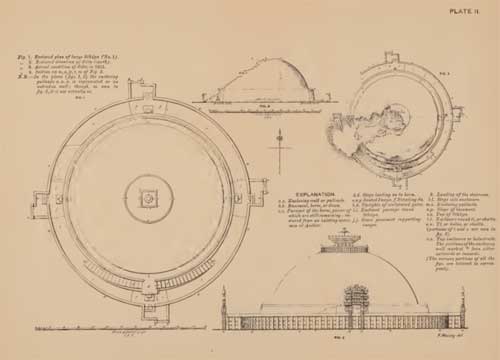
Enlarged floor plan of the Great Stupa. Source: "Sanchi and its Remains", F.C. Maisey, 1892.
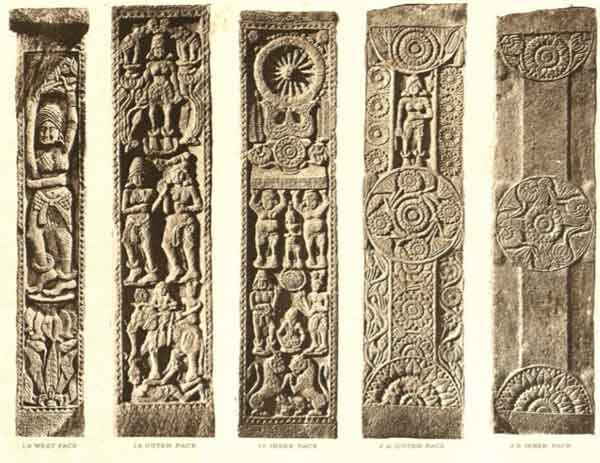
Reliefs on the ground railing of Stupa II at Sanchi. Source: "The Monuments of Sanchi", John Marshall and Alfred Foucher, 1902.
Conservation and the Preservation of Sanchi
An important precursor to the conservation and preservation efforts at Sanchi was the arrival of H.H. Cole at Sanchi in 1869. It was then that a massive project of copying, photographing and replicating of the Sanchi monuments took place along with the restoration of the structures. Concerted attempts were made by the British government in India from the 1880s to preserve the ancient site of Sanchi.
This first phase of conservation at the site was a welcome move on the part of the British authorities. However, this effort also proved to be disastrous for several smaller stupas around the main stupa which were displaced to accommodate the construction of a road leading up to the main monument. The restored southern gateway’s lintels were placed front-to-back. These mistakes were never reversed for the fear of damaging these structures further.
The second phase of such well-intentioned but ill-fated conservation was undertaken under the supervision of Mr. Cook, State Engineer at Bhopal in 1904. During the restoration work pillars and coping stones (the highest stone in any architectural structure) of the main railing around the Great Sanchi Stupa were destroyed or removed along with the inscriptions of the names of the donors on them. Such irreparable damage to the structures caused quite a furore in the archaeological and administrative circles. Lord Curzon, the Viceroy of India famously described these measures as the “ consecration of a desecration.”
The protection and care of the Sanchi Topes had become a special concern for the British Government. Lord Curzon was especially invested in the preservation of Sanchi since the time he visited the site in 1899. In November 1905, while passing through Bhopal he made the suggestion that the Topes might be handed over to the Government of India. However, Sultan Jahan, the Begum of Bhopal refused stating the Bhopal State’s intention to preserve the Buddhist complex as a monument of archaeological interest. She made arrangements for the protection and restoration of Sanchi.
The Bhopal state funded the next phase of restoration project of the Sanchi site undertaken by John Marshall, the Director General of Archaeology in India, between 1912 and 1919. He spent this time undoing the terrible damages that had reduced most of the stupas to a rubble at the site. A small on-site museum was instituted by Marshall at the foot of the hill. It was devoted to the care and preservation of antiquities that lay scattered around the site. The Bhopal Durbar extended full support in this matter as the Begum of Bhopal entirely financed the construction of this museum.
Return of the Sanchi caskets
In 1920 Lieutenant Colonel C.E. Luard, the Political Agent at Bhopal received a letter from the heir apparent to the Bhopal Durbar, Nawabzada Hamidullah Khan informing him about a few relic caskets and other objects which were taken away to the British Museum from Sanchi by Alexander Cunningham. He requested for their return in view of the fact that Sanchi had a museum of its own, so their claim on these valuable objects took precedence. Along with the letter he had enclosed a list of seventeen articles from Sanchi that were presently lodged at the British Museum which had been prepared by John Marshall in 1919.
When this matter of restoration of the Sanchi antiquities was referred by Luard to Marshall, he responded that the British Museum would not contemplate for a moment to return the original antiquities to Sanchi and he further warned that, “if such a precedent were once established the British Museum would quickly find itself despoiled of half its treasures, which would be demanded back by Greece, Egypt and Italy and a score of other countries”, urging the Political Agent to drop the said matter.
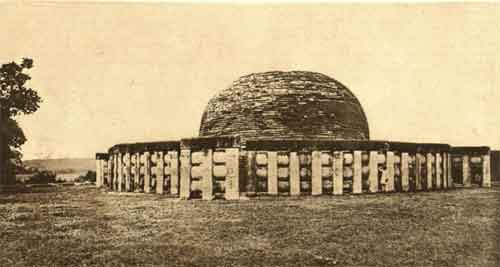
The Sanchi II Stupa at Sanchi after restoration. Source: The Monuments of Sanchi, John Marshall and Alfred Foucher, 1902.
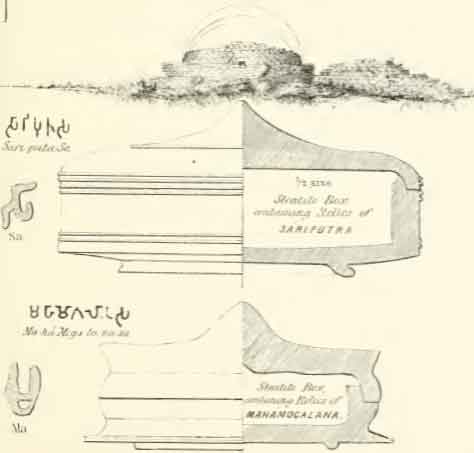
Drawings of relief caskets of Sariputra and Moggallana. Source: The Bhilsa Topes, Alexander Cunningham, 1854.
Nothing more was heard of the matter until the demand for the return of the Sanchi antiquities was reignited in 1940. It was reported in the Press that the relics of Sariputra and Moggallana (Buddha’s chief disciples) were to be handed over to the Maha Bodhi Society by the Victoria and Albert Museum to be enshrined at the Buddhist Temple in New Delhi. In 1938, the Government of India had received a request from the Maha Bodhi Society of Bombay to bring back the relics of Sariputra and Moggallana from the Victoria and Albert Museum, London. In 1939 the Museum decided to return the relics to the Maha Bodhi Society through an intervention by the Secretary of State for India. However, the transfer of the relics had to be postponed due to the outbreak of World War II.
The intervention of the war proved to be timely for the Bhopal Durbar. A letter reinstating the demand of the Bhopal Durbar for the antiquities was sent to L.G. Wallis, the Political Agent in Bhopal where it was stated that the Government of Bhopal were the owners of the relics and that these were to be restored to the Sanchi Museum which was deemed to be the most suitable place for them. They campaigned relentlessly for the return of the relics to Sanchi. They were prepared to make suitable arrangements for the relics in accordance with the religious requirements of the Buddhist pilgrims. The Bhopal Government was requested to persuade the Mahabodhi Society to enshrine the relics at Sanchi by the Government of India.
Accordingly, an agreement between the Government of Bhopal and the Maha Bodhi Society was reached in 1946, wherein it was decided that the relics would finally be enshrined at a newly constructed vihara in Sanchi. Finally, the relics in their original caskets were enshrined at the new Chetiyagiri Vihara in Sanchi on 30th November, 1952. In a grand and fitting ceremony attended by world and Buddhist leaders from Burma, Cambodia and Sri Lanka and the first Prime Minister of independent India, Pandit Jawaharlal Nehru the modern life of Sanchi as a national monument was henceforth inaugurated.
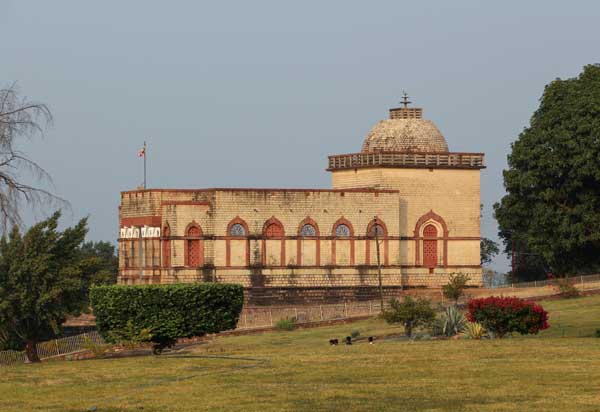
Chetiyagiri Vihara at Sanchi. Source: Wikipedia
 Government of Indiaa
Government of Indiaa

 Recognizing the ongoing need to position itself for the digital future, Indian Culture is an initiative by the Ministry of Culture. A platform that hosts data of cultural relevance from various repositories and institutions all over India.
Recognizing the ongoing need to position itself for the digital future, Indian Culture is an initiative by the Ministry of Culture. A platform that hosts data of cultural relevance from various repositories and institutions all over India.
